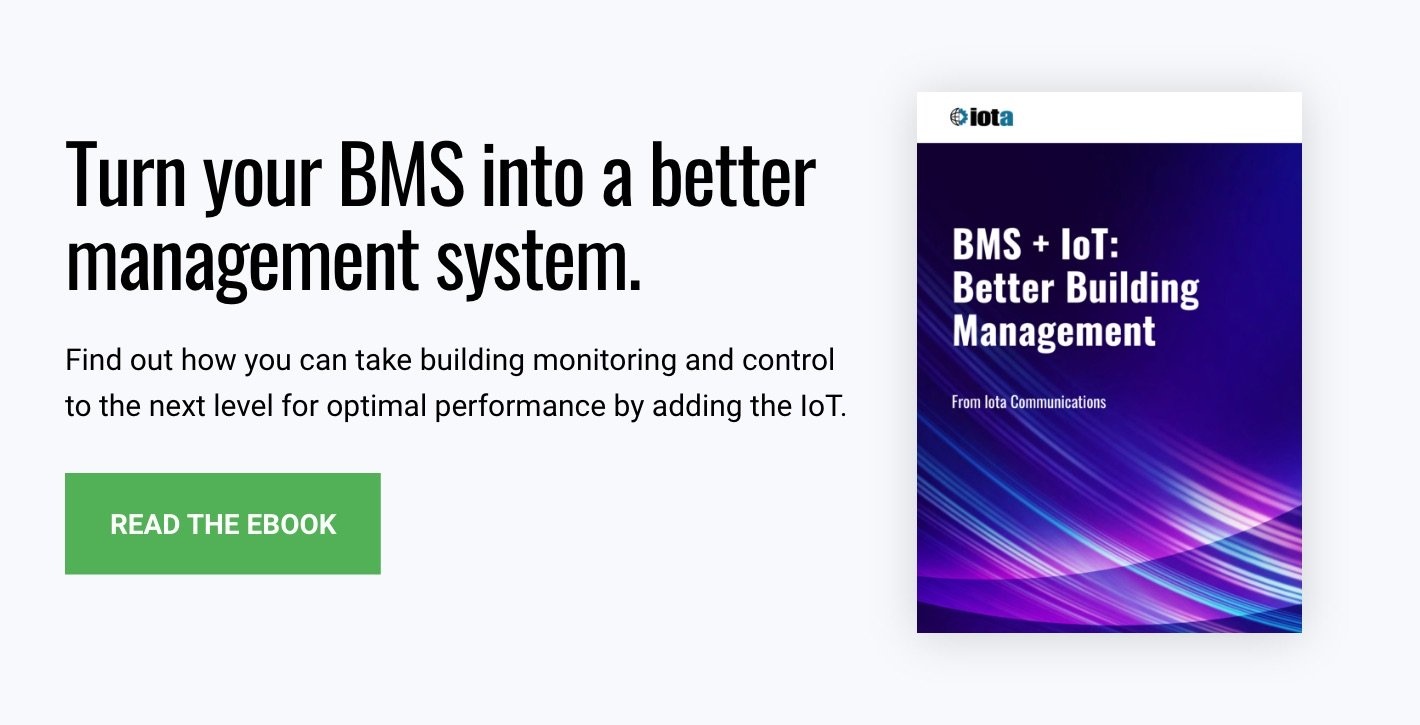As a facilities manager, does your building have the necessary components for you to:
- respond to changing weather conditions to optimize occupants’ comfort level and reduce your energy expenditure;
- predict when a core operating component (like the HVAC system or critical production equipment) is likely to break down, averting downtime and emergency maintenance;
- alter your HVAC and heating systems to reflect the real-time occupancy of various areas, saving money on energy consumption?
As awareness grows about how Internet of Things (IoT) data can impact facility management, so does the number of smart commercial buildings. The amount of data collected by smart buildings worldwide was just 1.2 zetabytes in 2010; in 2020 that number is expected to jump to 37.2. Smart buildings not only help you save money, but they also have a higher market value than non-connected buildings because they run more efficiently.
Looking for recommendations about ways your building can run more efficiently? Talk to us at Iota Communications.
Many buildings currently under construction have IoT solutions as part of their initial design, but with the right components you can bring the IoT to your existing building now. So what are the smart building components necessary to experience these benefits? There are four: IoT sensors, analytics software, a user interface, and a means of connectivity.
4 Smart Building Components
1. IoT Sensors
Sensors are the devices that monitor their environment and record or send that information (data) to a computer processor. The sensors typically communicate with an access point placed inside a building, which then communicates with a gateway. That gateway aggregates the sensor data and sends it on to the cloud.
Sensor technology has advanced over the years; today you can buy sensors to monitor a wide variety of things about your building. Some of the more common measurements for monitoring within a smart building ecosystem are:
- Temperature
- Humidity
- Light
- Motion
- Vibration
- Air quality
- Location, and more.
You have a lot of options when it comes to buying sensors, but it makes sense to purchase them bundled with the other components listed in this article for ease of use and optimum benefit. Things to consider when it comes to sensors are:
- Battery life—you don’t want to have to change the batteries on your sensors every year.
- Cost—they should be fairly inexpensive to make your solution cost-effective. Take into consideration how many you want to deploy, and how the sensors are designed and produced (i.e. are they a custom design to meet your special requirements or standard off-the-shelf sensors?).
2. Analytics Software
A key smart building component is the software that will help you understand the data collected by the sensors. Software extracts and analyzes the rich insights the data provides (“energy intelligence”), and helps you determine how to transform those insights into action.
In addition to sensor data, the software you use might also integrate other data sources—like weather data or utility rates—to determine a course of action. For example, using daily weather data and utility peak demand information, the software may recommend super-cooling the building at 10 or 11 A.M. instead of waiting until the temperature reaches a high point at 1 P.M. It will also calculate the savings you’ll see as a result of using less power from 12 P.M. to 3 P.M. Trying to correlate all that data yourself would take too much time; there’s also a greater likelihood you’ll miss out on potential opportunities for savings.
3. User Interface
The user interface is simply the way you and the software interact—the computer screens, icons, displays, etc. It’s important that information is delivered to you in a way that’s easy to access and simple to understand; and since the amount of data can be huge, it should also be able to process data efficiently. This may seem like a less significant smart building component than the rest, but the user experience in terms of software could mean the difference between a system that’s rarely used and one that’s used extensively—which will have an impact on the system’s success.
4. Connectivity
Finally, you need a way for your devices to communicate and connect to the Internet. Connectivity solutions include cellular and WiFi-based networking options. Cellular-based applications are a popular choice; they can operate over long ranges but are typically fairly expensive to use. WiFi, on the other hand, is a local area network that provides good coverage throughout most buildings, but many IT departments are hesitant to allow third-party IoT devices on their networks due to security concerns.
Another option is Iota Communications’ dedicated IoT network that can be used nationwide. Designed specifically for IoT connectivity, it avoids the security issues associated with WiFi; has greater signal penetration through walls and concrete structures than cellular; longer battery life for sensors; and is more cost-effective than cellular. Our network system connects the sensors to access points, which then transmit data to gateways, which are connected to the cloud. Our software analyzes the data so that any internet-connected device can review the actionable intelligence.It’s reliable, scalable, and secure.
Want to know more about smart building ecosystems?
Depending on your building and your specific needs, there are numerous ways to approach smart building implementation. We can help. Iota Communications has all the smart building components you need to get started, including a line of IoT sensors and an easy-to-use IoT platform that utilizes machine learning to maximize energy efficiencies. We can also conduct a building assessment to identify your current challenges, and recommend a course of action. If you’re interested in finding out more about what it’s like to partner with us, get in touch.


